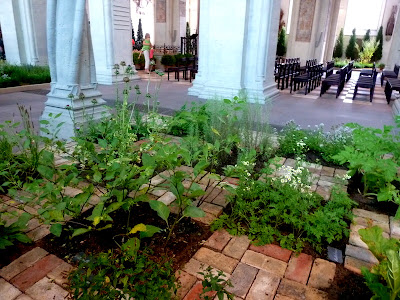Herb Garden
A festival is taking place until the end of October to celebrate 825 years of the "Marienaltar" in Brunswick Cathedral. The altar, with its five bronze columns which support a heavy, marble table, is the spiritual centre of the cathedral. It takes the form of a Romanesque "Table Altar," on which rests the holy scriptures, originally in the form of the Gospels of Henry the Lion, and at which the congregation celebrates Holy Communion.
In 2012, an anonymous, generous benefactor left €4000 on this altar, which enabled the children from Bath to visit Brunswick and to sing in the cathedral. At the end of their visit in early June, a gift was left for the benefactor on this altar by the Bath children. I took a peep on Friday, and could see no sign of the gift, which was left under the bible, where envelope of Euros had been donated. I hope the mystery donor, who continues to leave large amounts of money for good causes in churches throughout the city, has taken his or her token of thanks.
Lilies for Mary's purity and for remembrance.
The festival programme celebrates the historical and contemporary significance of the main altar, gifted to the cathedral by Henry the Lion, and which was blessed by Bishop Adelog of Hildesheim in 1188, in adoration of the Virgin Mary. Above, lilies surround one of the magnificent iron tombs.
Herb Garden
Words and music, art and the history of religion, piety and the enjoyment of art, are the facets of a rich programme of music, made possible by the commitment of the cantors of BS Cathedral. The music spans from Gregorian chant, via Palestrina and Bach to the present, with music by John Rutter. Unfortunately I will not be here to listen to this glorious music, and especially to a concert given by Choir of the Thomaskirche in Leipzig, one of the churches in which my hero JS Bach worked as cantor and organist. The choir will sing music by Bach, Palestrina, Wagner and Reger, together with a concert of organ works by Mulet and Guiraud.
The anniversary of the Romanesque Marienaltar from the time of Duke Henry the Lion and his wife Matilda of England, promotes the significance of the history of Romanesque art in the cathedral, with the Imervard Cross, the Marienaltar, the seven-armed Candlestick made around 1180, the stucco murals and the many grave monuments.
Apples and the Apple Tree.
The Marienaltar can be seen in the middle of the photo, to the right behind the column. Unfortunately I inadvertently failed to upload the best photo of the altar I took that day! The green of the plants and trees give the cathedral a wonderful, spiritual connection with the continuation of life. I wish we could all stop slaughtering one another, and finally live together in peace, in what could be a paradise on earth.




No comments:
Post a Comment